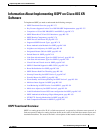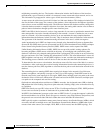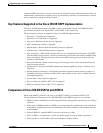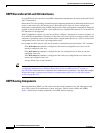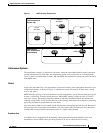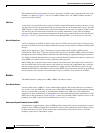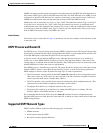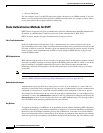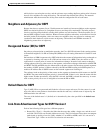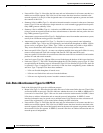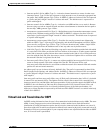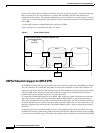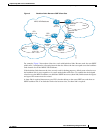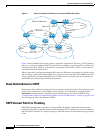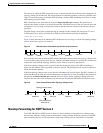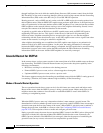
Implementing OSPF on Cisco IOS XR Software
Information About Implementing OSPF on Cisco IOS XR Software
RC-181
Cisco IOS XR Routing Configuration Guide
OL-14356-01
which devices start using the new key, and the software stops sending duplicate packets after it detects
that all of its neighbors are using the new key. The software then discards the old key. The network
administrator must then remove the old key from each the configuration file of each router.
Neighbors and Adjacency for OSPF
Routers that share a segment (Layer 2 link between two interfaces) become neighbors on that segment.
OSPF uses the hello protocol as a neighbor discovery and keep alive mechanism. The hello protocol
involves receiving and periodically sending hello packets out each interface. The hello packets list all
known OSPF neighbors on the interface. Routers become neighbors when they see themselves listed in
the hello packet of the neighbor. After two routers are neighbors, they may proceed to exchange and
synchronize their databases, which creates an adjacency. On broadcast and NBMA networks all
neighboring routers have an adjacency.
Designated Router (DR) for OSPF
On point-to-point and point-to-multipoint networks, the Cisco IOS XR software floods routing updates
to immediate neighbors. No DR or backup DR (BDR) exists; all routing information is flooded to each
router.
On broadcast or NBMA segments only, OSPF minimizes the amount of information being exchanged on
a segment by choosing one router to be a DR and one router to be a BDR. Thus, the routers on the
segment have a central point of contact for information exchange. Instead of each router exchanging
routing updates with every other router on the segment, each router exchanges information with the DR
and BDR. The DR and BDR relay the information to the other routers. On broadcast network segments
the number of OSPF packets is further reduced by the DR and BDR sending such OSPF updates to a
multicast IP address that all OSPF routers on the network segment are listening on.
The software looks at the priority of the routers on the segment to determine which routers are the DR
and BDR. The router with the highest priority is elected the DR. If there is a tie, then the router with the
higher router ID takes precedence. After the DR is elected, the BDR is elected the same way. A router
with a router priority set to zero is ineligible to become the DR or BDR.
Default Route for OSPF
Type 5 (ASE) LSAs are generated and flooded to all areas except stub areas. For the routers in a stub
area to be able to route packets to destinations outside the stub area, a default route is injected by the
ABR attached to the stub area.
The cost of the default route is 1 (default) or is determined by the value specified in the default-cost
command.
Link-State Advertisement Types for OSPF Version 2
Each of the following LSA types has a different purpose:
• Router LSA (Type 1)—Describes the links that the router has within a single area, and the cost of
each link. These LSAs are flooded within an area only. The LSA indicates if the router can compute
paths based on quality of service (QoS), whether it is an ABR or ASBR, and if it is one end of a
virtual link. Type 1 LSAs are also used to advertise stub networks.



